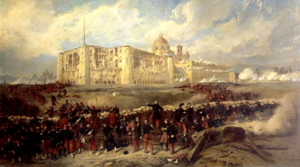| Second French intervention in Mexico | |||||||
|---|---|---|---|---|---|---|---|
 French assault during the Second Battle of Puebla | |||||||
| |||||||
| Belligerents | |||||||
|
| |||||||
| Commanders and leaders | |||||||
| Strength | |||||||
| Casualties and losses | |||||||
|
| ||||||
| History of Mexico |
|---|
 |
| Timeline |
|
|
The second French intervention in Mexico (Spanish: segunda intervención francesa en México), also known as the Second Franco-Mexican War (1861–1867),[12] was a military invasion of the Republic of Mexico by the French Empire of Napoleon III, purportedly to force the collection of Mexican debts in conjunction with Great Britain and Spain. Mexican conservatives supported the invasion, since they had been defeated by the liberal government of Benito Juárez in a three-year civil war. Defeated on the battlefield, conservatives sought the aid of France to effect regime change and establish a monarchy in Mexico, a plan that meshed with Napoleon III's plans to re-establish the presence of the French Empire in the Americas. Although the French invasion displaced Juárez's Republican government from the Mexican capital and the monarchy of Archduke Maximilian was established, the Second Mexican Empire collapsed within a few years. Material aid from the United States, whose four-year civil war ended in 1865, invigorated the Republican fight against the regime of Maximilian, and the 1866 decision of Napoleon III to withdraw military support for Maximilian's regime accelerated the monarchy's collapse. Maximilian and two Mexican generals were executed by firing squad on 19 June 1867, ending this period of Mexican history.
The intervention came as a civil war, the Reform War, had just concluded, and the intervention allowed the Conservative opposition against the liberal social and economic reforms of President Juárez to take up their cause once again. The Mexican Catholic Church, Mexican conservatives, much of the upper-class and Mexican nobility, and some Native Mexican communities invited, welcomed and collaborated with the French empire's help to install Maximilian of Habsburg as Emperor of Mexico.[13] The emperor himself however proved to be of liberal inclination and continued some of the Juárez government's most notable liberal measures. Some liberal generals defected to the Empire, including the powerful, northern governor Santiago Vidaurri, who had fought on the side of Juárez during the Reform War.
The French army landed in 1861, aiming to rapidly take the capital of Mexico City, but Mexican republican forces defeated them in the Battle of Puebla on 5 May 1862, Cinco de Mayo, delaying their taking the capital for a year. The French and Mexican Imperial Army captured much of Mexican territory, including major cities, but guerrilla warfare by supporters of the republic remained a significant factor and Juárez himself never left the national territory. The intervention was increasingly using up troops and money at a time when the recent Prussian victory over Austria was inclining France to give greater military priority to European affairs. The liberals also never lost the official recognition of the United States of America in spite of their ongoing civil war, and following the defeat and surrender of the Confederate States of America in April 1865 the reunited country began providing materiel support to the republican forces. Invoking the Monroe Doctrine, the U.S. government asserted that it would not tolerate a lasting French presence on the continent. Facing the mounting pressure both at home and abroad, the French army began to redeploy to Europe in 1866, and the Second Mexican Empire collapsed in 1867.[13]
- ^ a b c Gustave Niox (1874). Expédition du Mexique, 1861–1867; récit politique & militaire (in French). Paris: J. Dumaine. ASIN B004IL4IB4. Retrieved 10 June 2020.
- ^ Conaway, William J. (2010). A Gringo Guide to Mexican History. William J Conaway. ISBN 978-0976580577.
- ^ Miller, Robert Ryal (2015). Mexico: A History. University of Oklahoma Press. ISBN 978-0806175270.
- ^ a b c Jean-Charles Chenu (1877). "Expédition du Mexique" [Mexican expedition]. Aperçu sur les expéditions de Chine, Cochinchine, Syrie et Mexique : Suivi d'une étude sur la fièvre jaune par le Dr Fuzier [Overview of the expeditions in China, Cochinchina, Syria and Mexico: A Follow-up study on the yellow fever by Dr. Fuzier] (in French). Paris: Masson. Retrieved 22 June 2012.
- ^ Martín de las Torres (1867). El Archiduque Maximiliano de Austria en Méjico (in Spanish). Barcelona: Luis Tasso. ISBN 978-1271445400. Retrieved 10 June 2020.
- ^ Robert Ryal Miller (1961). "The American Legion of Honor in Mexico". Pacific Historical Review. 30 (3). Berkeley: University of California Press: 229–241. doi:10.2307/3636920. ISSN 0030-8684. JSTOR 3636920.
- ^ a b Walter Klinger (2008). Für Kaiser Max nach Mexiko – Das Österreichische Freiwilligenkorps in Mexiko 1864/67 (in German). Munich: Grin Verlag. ISBN 978-3640141920. Retrieved 10 June 2020.
- ^ a b c d e f Clodfelter 2017, p. 305.
- ^ Péter Torbágyi (2008). Magyar kivándorlás Latin–Amerikába az első világháború előtt (PDF) (in Hungarian). Szeged: University of Szeged. p. 42. ISBN 978-963-482-937-9. Retrieved 10 June 2020.
- ^ René Chartrand (1994). Lee Johnson (ed.). The Mexican Adventure 1861–67. Men-at-arms. Vol. 272. Illustrated by Richard Hook. Oxford, UK: Osprey Publishing. ISBN 185532430X.
- ^ Richard Leslie Hill; Peter C. Hogg (1995). A Black corps d'élite: an Egyptian Sudanese conscript battalion with the French Army in Mexico, 1863–1867, and its survivors in subsequent African history. East Lansing, US: Michigan State University Press. ISBN 978-0870133398.
- ^ known in France as Expédition du Mexique at the time and today as Intervention française au Mexique
- ^ a b Kohn, George Childs, ed. (2007). Dictionary of Wars (3rd ed.). New York: Facts on File. p. 329. ISBN 978-1-4381-2916-7. OCLC 466183689.